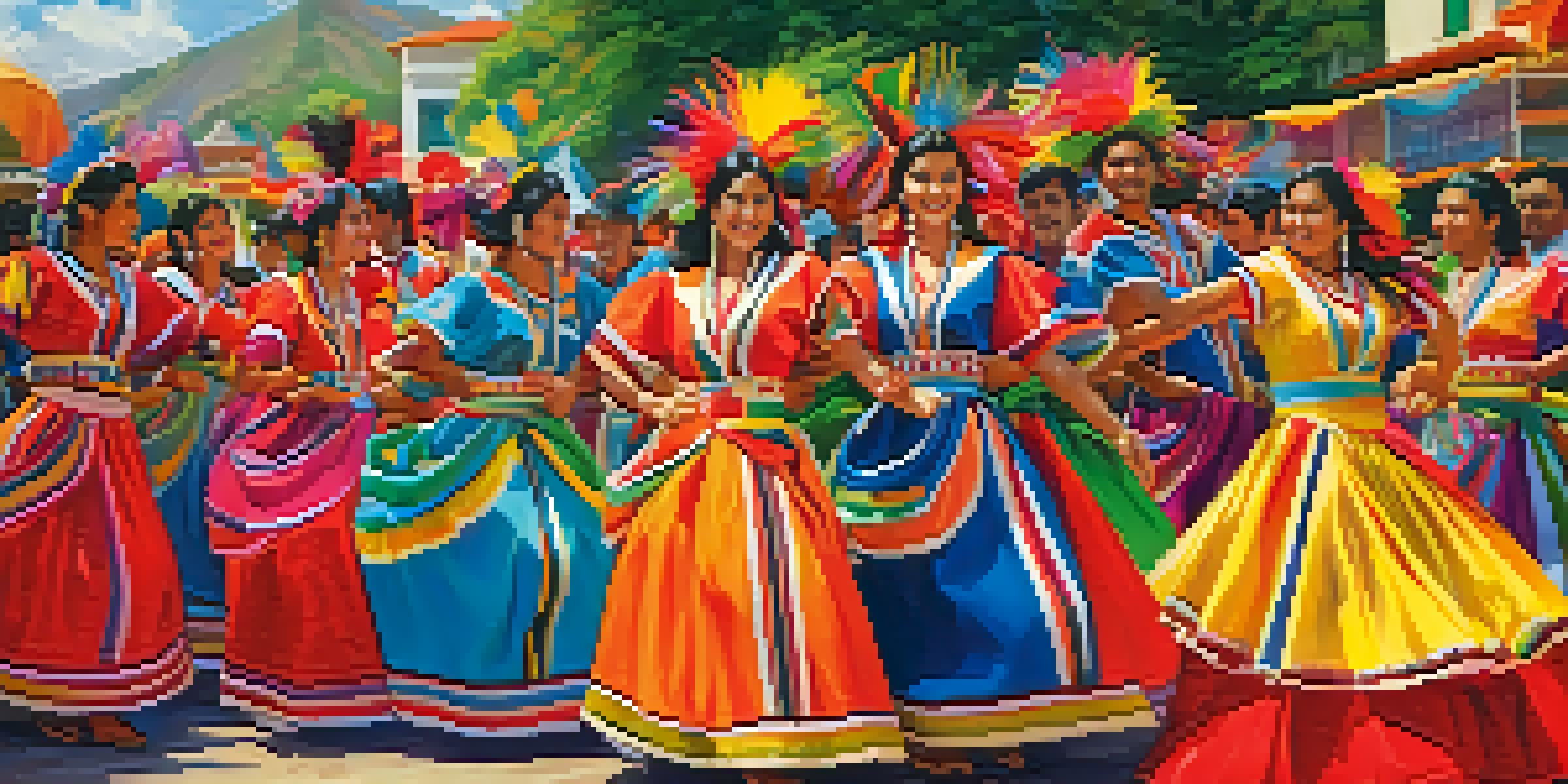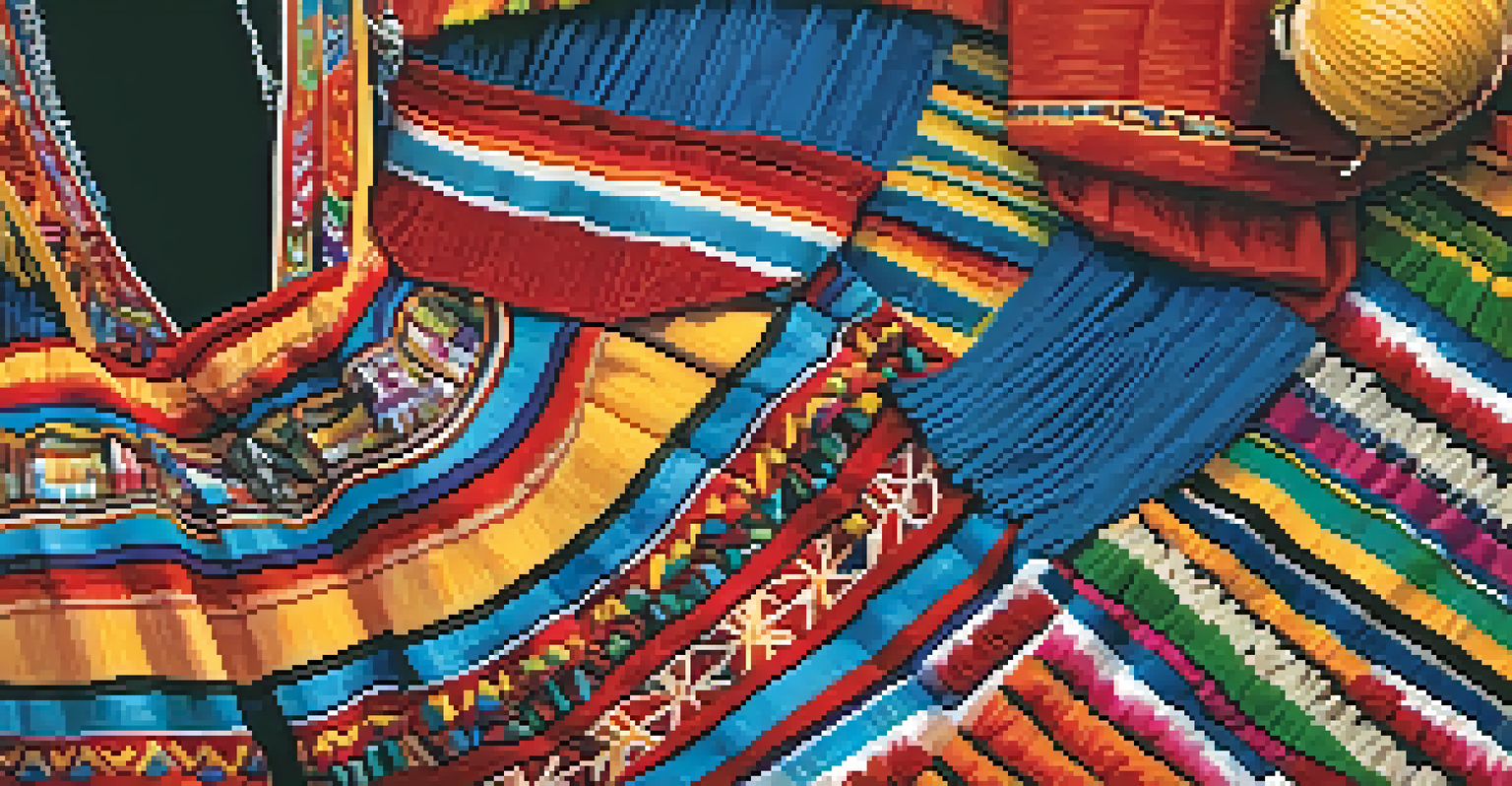Understanding the Origins of Peruvian Folkloric Dance Forms

The Cultural Melting Pot of Peru
Peru's diverse geography and history have shaped its cultural landscape, making it a melting pot of traditions. From the Andes mountains to the Amazon rainforest, each region contributes unique elements to the nation’s identity. This diversity is beautifully reflected in its folkloric dance forms, which blend Indigenous, Spanish, and African influences. Understanding these origins is key to appreciating the rich tapestry of Peruvian dance.
Dance is the hidden language of the soul.
For example, the Andean region is known for its colorful costumes and lively rhythms that echo ancient rituals. In contrast, coastal dances often showcase the influence of Afro-Peruvian culture, with their distinct movements and musical styles. This blend of cultures not only defines Peruvian dance but also highlights the resilience and adaptability of its people. It's a dance of survival and celebration.
As we explore the various folkloric dance forms, we will see how they embody stories, beliefs, and the daily lives of the communities that perform them. Each dance tells a story, making it a vital expression of cultural heritage. This journey through dance is not just about movement; it's about connecting with the past and preserving cultural identity.
Indigenous Roots in Peruvian Dance
Many Peruvian folkloric dances trace their origins back to ancient Indigenous cultures, such as the Inca. These dances often celebrate agricultural cycles, religious beliefs, and historical events. For instance, the 'Wititi' dance from the Colca Valley is performed during harvest festivals to honor Pachamama, or Mother Earth, showcasing the deep spiritual connection Indigenous peoples have with nature.

The movements and rhythms of these dances are often inspired by the natural world, mimicking the sounds of animals, wind, and water. This connection to the environment not only pays homage to their ancestors but also reinforces cultural identity. The use of traditional instruments, like the charango and the pan flute, further enhances the authenticity of these performances.
Peru's Dance Reflects Cultural Diversity
Peruvian folkloric dance is a vibrant blend of Indigenous, Spanish, and African influences, showcasing the country's rich cultural heritage.
Understanding these Indigenous roots is essential for appreciating the significance of folkloric dances in contemporary Peru. They are more than just art forms; they are living expressions of history and spirituality. As these dances evolve, they continue to reflect the values and struggles of Indigenous communities today.
Spanish Influence on Folk Dance
The arrival of Spanish colonizers in the 16th century marked a significant turning point in Peruvian culture, especially in dance. The fusion of Spanish and Indigenous elements gave rise to new styles and rhythms, creating a unique dance identity. Dances like the 'Marinera' and 'Festejo' showcase this blending, with their elegant movements and vibrant music that echo both European and local traditions.
Culture is the widening of the mind and of the spirit.
Spanish influence is evident in the use of specific dance techniques and forms, as well as in the introduction of new instruments like the guitar and violin. These instruments have become staples in many folkloric ensembles, enriching the musical landscape of Peruvian dance. The incorporation of Spanish dance styles, such as flamenco, further illustrates this cross-cultural exchange.
While some might view this influence as a loss of Indigenous identity, many Peruvian dancers embrace it as a testament to their adaptability. Rather than erasing Indigenous roots, the Spanish influence has added layers to the rich narrative of Peruvian folklore. This blend of cultures is celebrated in performances, reminding us of the complex history that shapes modern Peru.
The Impact of African Heritage
The African influence on Peruvian folkloric dance is particularly prominent in coastal regions, where enslaved Africans were brought during the colonial era. This heritage is vibrantly expressed through dances like the 'Lando' and 'Zamba,' which feature rhythmic movements and dynamic footwork. These dances are characterized by their call-and-response patterns, often involving lively interaction between dancers and musicians.
The use of percussion instruments, such as drums and cajóns, is a hallmark of Afro-Peruvian music and dance. These instruments create infectious rhythms that invite participation and celebration. The communal aspect of these dances reflects the African cultural value of togetherness and resilience, showcasing how dance serves as a form of expression and solidarity.
Modern Trends in Traditional Dance
Contemporary dancers are reinterpreting traditional Peruvian dance forms by incorporating modern elements to engage younger audiences.
Today, Afro-Peruvian dance forms are gaining recognition both locally and internationally, highlighting the importance of this cultural contribution. They remind us of the complex history of Peru and the diverse influences that have shaped its identity. Understanding the impact of African heritage in Peruvian dance allows us to appreciate the depth and richness of this cultural tapestry.
Modern Interpretations of Traditional Dances
As society evolves, so do the dance forms of Peru. Many contemporary dancers are reinterpreting traditional styles, infusing them with modern elements while respecting their roots. This evolution is evident in performances that blend traditional dance with contemporary music, creating a unique fusion that resonates with younger audiences.
For instance, the integration of hip-hop and urban dance styles into traditional forms has opened up new avenues for expression. Dancers often use these modern elements to address social issues, bridging the gap between tradition and contemporary life. This innovative approach not only keeps the dances relevant but also engages a broader audience.
However, this modernization raises questions about the preservation of cultural authenticity. While it's essential to adapt and grow, maintaining a connection to the origins of these dances is crucial. Striking a balance between innovation and tradition ensures that the essence of Peruvian folkloric dance is celebrated and passed on to future generations.
Festivals Celebrating Peruvian Dance
Festivals play a vital role in the preservation and celebration of Peruvian folkloric dance. Events like the 'Fiesta de la Candelaria' and 'Inti Raymi' not only showcase traditional dances but also involve the entire community in the festivities. These celebrations are a vibrant expression of cultural pride, drawing locals and tourists alike to witness the beauty and diversity of Peruvian dance.
During these festivals, dancers don intricate costumes that reflect the colors and symbolism of their cultural heritage. Each performance tells a story, whether it's a tribute to the harvest, a celebration of love, or a reflection on historical events. The energy and enthusiasm of the participants create an atmosphere of joy and unity, reinforcing the importance of cultural traditions.
Dance as a Cultural Identity Tool
Folkloric dance plays a crucial role in expressing community history and values, fostering a strong sense of belonging and cultural identity.
Moreover, these festivals serve as platforms for younger generations to learn and engage with their heritage. Workshops and performances allow aspiring dancers to connect with experienced artists, ensuring that the knowledge and skills are passed down. The continuation of these traditions fosters a sense of belonging and identity within the community.
The Role of Dance in Cultural Identity
Peruvian folkloric dance is more than just entertainment; it’s a vital aspect of cultural identity. Through dance, communities express their history, values, and beliefs, creating a sense of belonging. Each movement, rhythm, and costume carries significance, reflecting the shared experiences of the people. This connection to culture allows individuals to explore their roots and find pride in their heritage.
In many ways, dance acts as a bridge between generations. Elders pass down stories and traditions, while younger dancers reinterpret them for contemporary audiences. This intergenerational exchange fosters a greater understanding of cultural heritage and its relevance in modern society. It reinforces the idea that dance is a living art form, continuously evolving while honoring the past.

As globalization influences cultures worldwide, preserving the authenticity of Peruvian folkloric dance becomes increasingly important. Engaging with these traditions not only enriches personal identity but also promotes cultural diversity on a global scale. By valuing and celebrating these dance forms, we contribute to the vibrant mosaic of human expression.